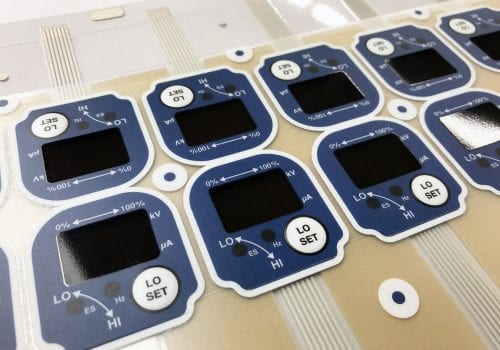Everything About Membrane layer Switch Over: A Comprehensive Overview for Beginners
Membrane layer switches are vital elements in contemporary electronic devices, using an one-of-a-kind user interface for user interaction - membrane switch. Their layered building, including overlays and conductive traces, supplies capability and resilience. Unlike typical mechanical buttons, membrane switches offer a streamlined design and customizable alternatives. Recognizing their crucial features and advantages can change product design. The details of their application and design considerations warrant additional exploration.
What Is a Membrane layer Change?
A membrane switch is a kind of electric button that contains a flexible membrane layer layered over a printed circuit card. This design enables a compact and sleek user interface, usually made use of in various electronic tools. Membrane buttons are typically discovered in consumer home appliances, medical equipment, and industrial machinery as a result of their sturdiness and resistance to environmental factors.The construction commonly consists of several layers, such as visuals overlays and sticky support, which supply tactile comments and protect the wiring below. The operation of a membrane layer button is started when stress is put on the surface, finishing an electric circuit.These switches are valued for their versatility, allowing personalized designs and published graphics that deal with certain interface. Their inconspicuous nature lowers area needs, making them suitable for applications where conventional buttons may not fit. On the whole, membrane layer switches provide a useful and aesthetic remedy for modern electronic gadgets.
Trick Components of Membrane Switches
Membrane layer changes make up a number of vital elements that add to their functionality and performance. The leading layer, understood as the overlay, offers the interface and is often printed with graphics or signs. Below the overlay lies a spacer layer, which separates the conductive aspects and protects against unintentional activation. The following essential component is the graphic layer, which enhances visual appeals and ensures the durability of the design.Conductive traces, commonly made from products like silver or carbon, are printed on the circuit layer. When pressure is related to the overlay, these traces enter call, finishing the circuit. In addition, a backing layer offers architectural support and can be made from products such as polyester or polycarbonate. Together, these elements produce a dependable, easy to use user interface suitable for different applications, from house appliances to industrial equipment. Comprehending these aspects is necessary for anyone curious about membrane switch innovation.
Exactly How Membrane Switches Over Work
Understanding exactly how membrane layer changes feature is important for appreciating their widespread usage in various devices. A membrane switch runs via a series of layers, consisting of a graphic overlay, spacer, and a circuit layer. When stress is related to the overlay, it compresses the spacer layer, enabling the circuit layer to make call and complete an electrical circuit. This action sends out a signal to the device, prompting a reaction, such as activating a light or triggering a function.Membrane changes can be made with different functions, including responsive comments, backlighting, and custom-made graphics, enhancing customer communication. Their construction enables for a sealed style, shielding the inner elements from dirt, moisture, and contaminants. This durability makes them suitable for varied applications, from consumer electronics to industrial tools. On the whole, the simpleness and effectiveness of membrane layer switches over add to their appeal in contemporary innovation.
Benefits of Membrane Layer Switches Over Mechanical Switches
While mechanical buttons have actually long been a staple in numerous gadgets, membrane switches over deal distinctive benefits that make them progressively appealing. One substantial benefit is their slim account, enabling more small layouts and better flexibility in product advancement. In addition, membrane changes feature a consistent surface, which boosts visual charm and streamlines cleaning, making them suitable for settings where hygiene is critical.Another advantage is their resistance to dust and moisture. Unlike mechanical buttons, which can be jeopardized by environmental factors, membrane layer switches give a closed user interface that secures versus impurities - membrane switch. Membrane switches usually have a longer lifespan due to less relocating parts, resulting in enhanced toughness and reliability.Cost-effectiveness is also a significant advantage, as membrane buttons can be generated in bulk with reduced production costs. These aspects incorporate to place membrane layer switches as a functional alternative to standard mechanical alternatives in numerous applications
Common Applications of Membrane Switches
Membrane switches are widely utilized in various markets, especially in consumer electronics and industrial control panels. In customer devices, they offer a streamlined, user-friendly user interface, while in commercial settings, they boost toughness and functionality. Comprehending these applications highlights the convenience and practicality of membrane layer switches in contemporary innovation.
Consumer Electronics Devices
As consumer electronics proceed to develop, membrane buttons have actually come to be a popular choice for a variety of gadgets due to their convenience and streamlined style. These buttons are frequently discovered in mobile phones, tablet computers, and push-button controls, where area is restricted and visual appeals issue. Their low profile and customizable layouts enable producers to produce straightforward user interfaces that enhance the total user experience. Additionally, membrane buttons are frequently utilized in devices such as microwaves and coffee manufacturers, supplying instinctive control options while resisting dampness and dirt. The resilience and reliability of membrane layer switches over make them ideal for day-to-day customer products, making sure durability and regular performance. On the whole, their integration in customer electronic devices mirrors a mix of performance and modern-day layout.
Industrial Control Panels
The applications of membrane changes extend past consumer electronic devices, locating considerable usage in commercial control panels. These switches are favored for their durability and resistance to rough atmospheres, making them suitable for producing and procedure control setups. They supply a dependable user interface for drivers to manage machinery, display processes, and readjust setups. Membrane layer switches can be his explanation tailored to suit details operational requirements, integrating features like backlighting and responsive responses, boosting user experience. Their low-profile design enables for combination right into different devices, while their capability to hold up against spills, dirt, and severe temperatures warranties long life. In general, membrane switches contribute to safe and reliable procedure in industrial applications, showing their convenience and effectiveness in demanding settings.
Factors To Consider for Designing Membrane Switches Over
When making membrane layer buttons, picking the appropriate products is necessary to ensure sturdiness and functionality. Additionally, recognizing layer arrangement techniques can substantially influence the button's performance and user experience. These considerations play an important duty in creating reputable and effective membrane layer button designs.
Product Choice Value
Material selection plays an important role in the style and functionality of membrane switches. The selected products directly impact the button's sturdiness, responsive feedback, and general visual. Key factors to consider consist of the substrate, which must give structural honesty while check out this site enabling versatility, and the visuals overlay, which requires to be immune to put on and ecological aspects. Conductive products need to assure reputable electrical performance, while adhesives must use strong bonding without endangering the switch's procedure. In addition, compatibility with manufacturing procedures and end-user settings is vital; materials need to stand up to varying temperatures, humidity degrees, and chemical direct exposure. Inevitably, appropriate product choice not only boosts the membrane layer button's performance yet likewise contributes to its long life and user contentment, making it an essential aspect of the style procedure.

Layer Setup Techniques

Regularly Asked Inquiries
How Much Time Do Membrane Layer Switches Normally Last?
Membrane layer switches normally have a lifespan of 1 to 5 million cycles, depending on usage and environmental problems. Variables such as layout quality and operating regularity greatly affect their durability and total performance longevity.

Can Membrane Changes Be Custom-made for Particular Layouts?
Membrane layer switches can certainly be customized to fit specific designs, enabling varied forms, colors, and functionalities. This adaptability enables makers to tailor these switches to fulfill special visual and operational demands properly.
What Products Are Made Use Of in Membrane Change Building?
Membrane layer buttons are normally constructed utilizing products such as polyester, polycarbonate, and glue layers. These materials supply versatility, resistance, and toughness to ecological aspects, making certain the buttons work successfully in numerous applications and problems.
Are Membrane Layer Changes Water Resistant or Immune to Wetness?
Membrane layer buttons can be designed to be moisture-resistant, using specialized materials and finishings. However, their water-proof capacities depend on building and construction top quality and details applications, making it necessary to assess needs for perfect performance in different atmospheres.
Just How Are Membrane Layer Switches Over Fixed if Harmed?
Fixing broken membrane layer switches over generally entails changing the impacted layer or circuit. Professionals might likewise use conductive glue or make use of specialized repair service kits, making sure capability is brought back without total substitute of the whole button setting up. Unlike standard mechanical buttons, membrane layer switches present a sleek design and customizable alternatives. A membrane switch is a kind of electric button that consists of a versatile membrane layer this contact form layered over a published circuit board. The operation of a membrane layer button is initiated when stress is applied to the surface, completing an electrical circuit.These switches are valued for their convenience, enabling customized styles and printed graphics that cater to particular individual interfaces. While mechanical buttons have actually long been a staple in several devices, membrane changes offer unique advantages that make them progressively appealing. Membrane buttons generally have a longer life expectancy due to fewer moving parts, resulting in enhanced toughness and reliability.Cost-effectiveness is also a noteworthy benefit, as membrane layer switches can be generated in mass with lower production prices.